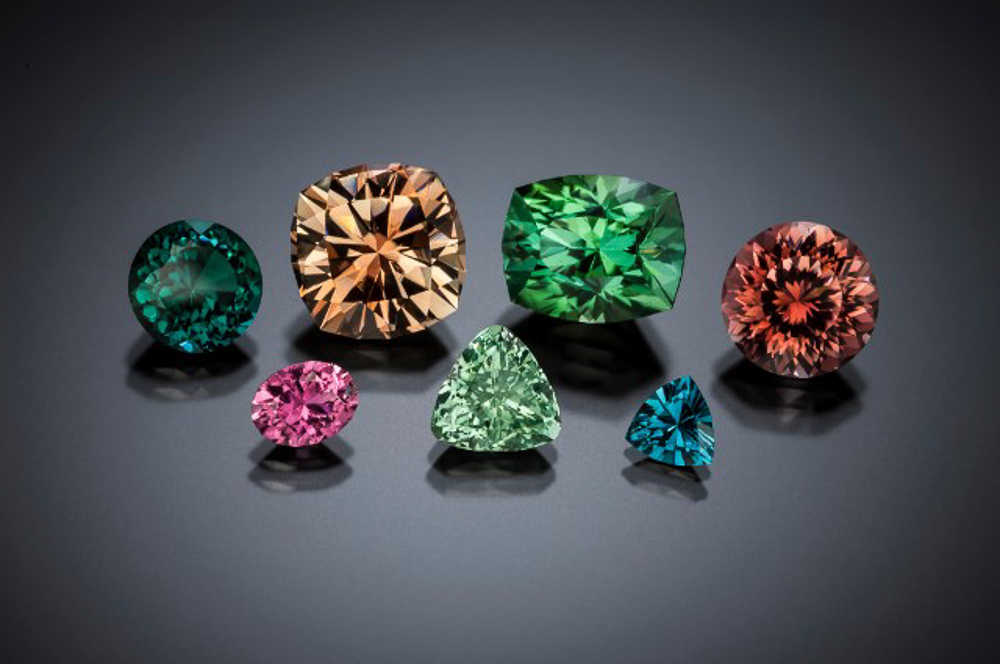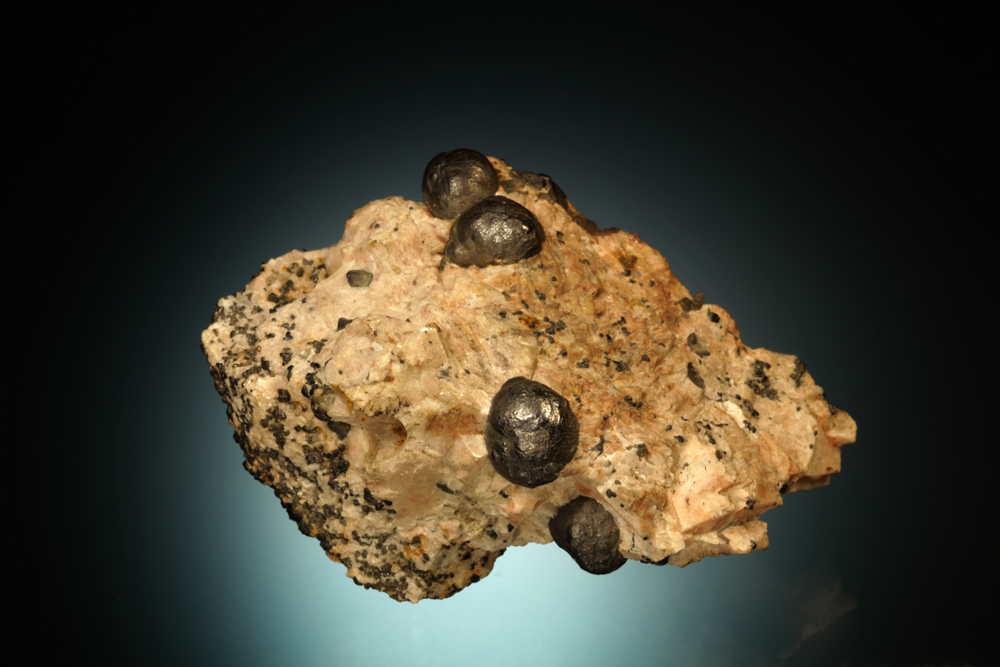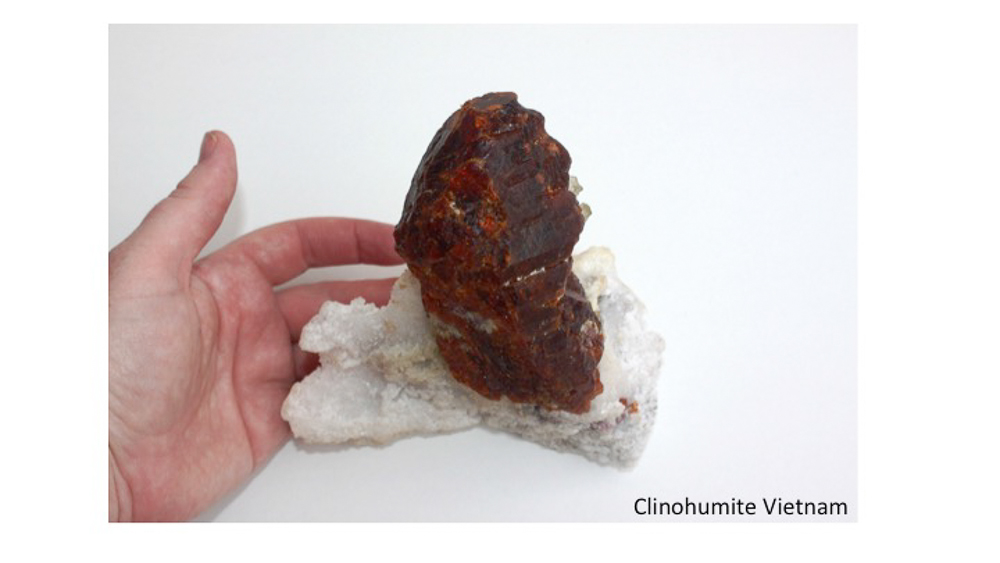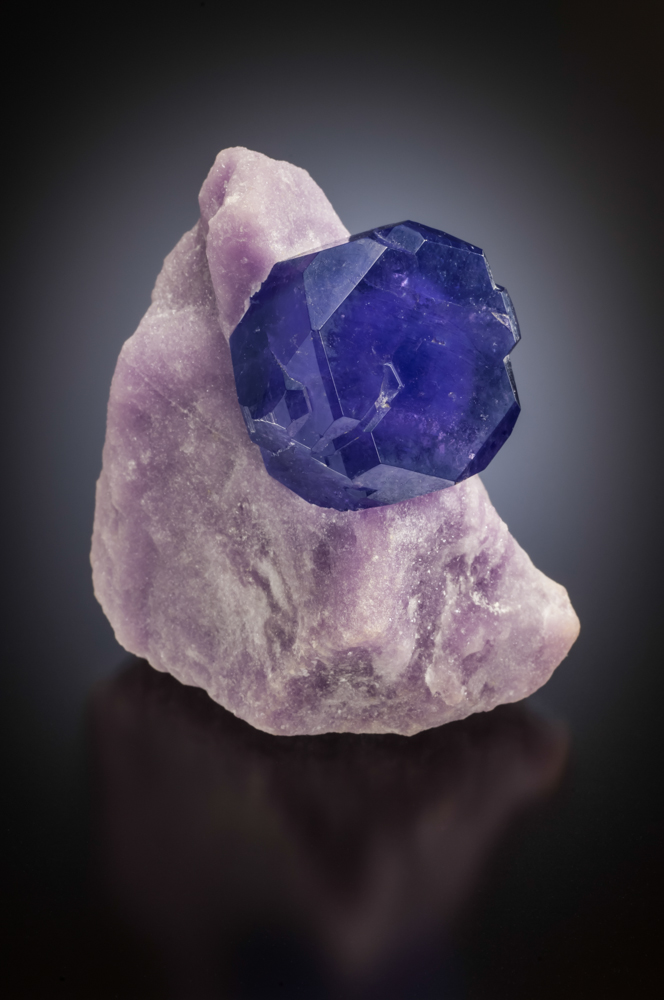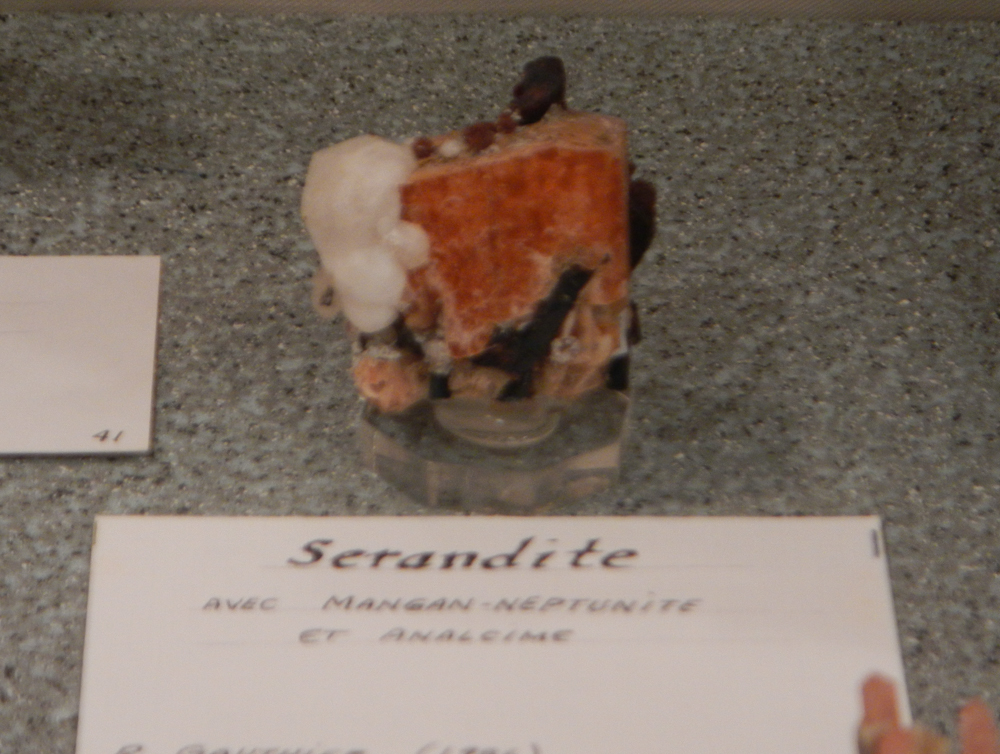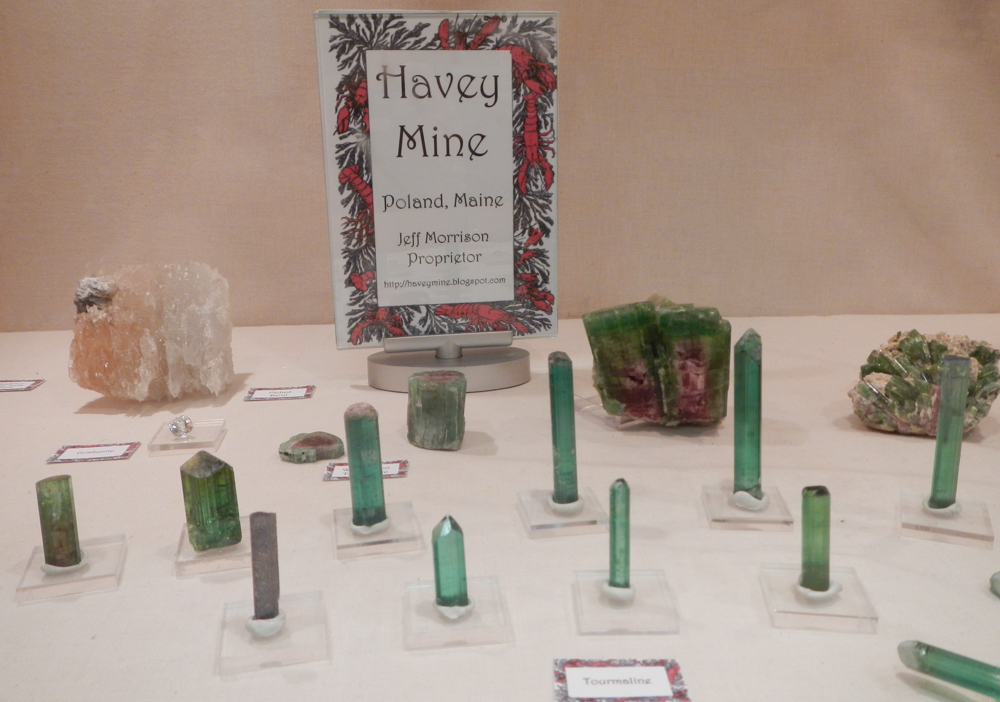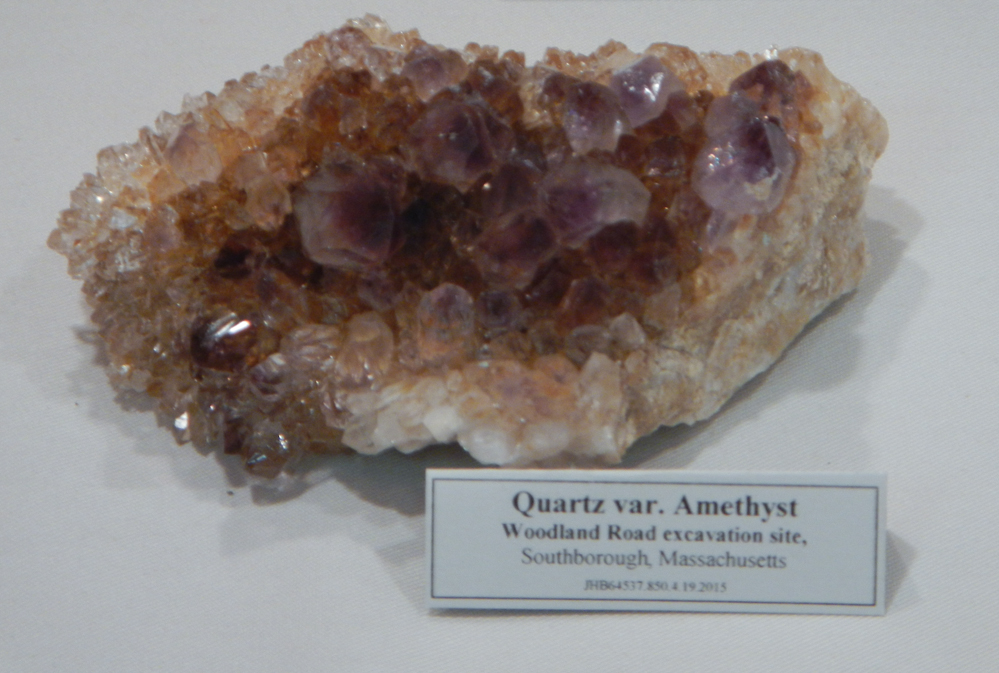Categories
Archives
This year, in this part of the world, “Rochester” (the Rochester Mineralogical Symposium) and spring sure couldn’t come soon enough – truly a happy breath of fresh air and promise of a new mineral collecting season after a tough winter.
Although arrivals in Rochester were initially greeted by cold and lingering recent snow, a few signs of spring were beginning to show. And yet once the mineral fun starts, who cares what the weather is doing?
[Note to Mother Nature: that is not a dare for next year’s Symposium. I mean unless you want to rain fine mineral specimens.]
About the Rochester Mineralogical Symposium
Just a word about Rochester. If you’ve never been, plan to come next year! Dates: April 14-17, 2016.
Rochester is a symposium meant for people who love minerals. It is not purely academic or technical, but involves these elements. Presentations range in content, with new discoveries and research in specimen mineralogy, yet accessible to people at all levels of expertise. The overall content is a great mix of mineralogy, photography, historical content, research, collecting information and glimpses of amazing places and people around the world. For fun, sense of community, contribution and cameraderie – and for the excellence of the presentations and displays – this is by far one of the best mineral events of the year, anywhere. And speaking of contribution, please note that the speakers were all generous in sharing their photographs and related permissions for this post – thank you all! Organized by Steve and Helen Chamberlain, along with a team of dedicated volunteers, the Rochester Mineralogical Symposium is not to be missed.
The Symposium also includes good opportunities to acquire specimens – the fourth floor of the hotel is the dealers’ floor, and dealer rooms are open most hours of day or night that are not occupied by the speaking schedule.
The 2015 Rochester Mineralogical Symposium (April 23-26) was a super event, featuring excellent presentations by speakers from a few different countries.
In case you were not there – and of course even if you were – I hope you will enjoy reading about it and looking at a few of the photos. (For further reading, there is also a Links and References section at the end of this post.)
Presentations
On opening night, we were treated to a return visit by Dr. Peter Lyckberg, speaking on the subject of “Gem Pegmatites of Afghanistan and Pakistan”. This subject immediately conjures up images of the well-known gem crystals, and although spectacular specimens were of course part of the evening, Peter’s presentation was about so much more than specimen photos, with lots of food for thought. Photos of the development of some of the major pegmatites over the years allowed us to appreciate the massive scope of some of these deposits (almost hard to believe) – and the massive efforts to mine them. Peter’s journeys into these mountain regions gave a glimpse into how hard this part of the world is, at incredible altitudes that would stop most people in their tracks. The local people and Peter’s approach with them created bonds of friendship and lasting relationships. Peter travelled into these areas as as stranger from far away, was befriended by local people who took him to their mines, and who showed kindness and support for his trip as he worked to document the pegmatites. He has bought from them and has supported their work to an extent that has had a meaningful positive impact on their lives.
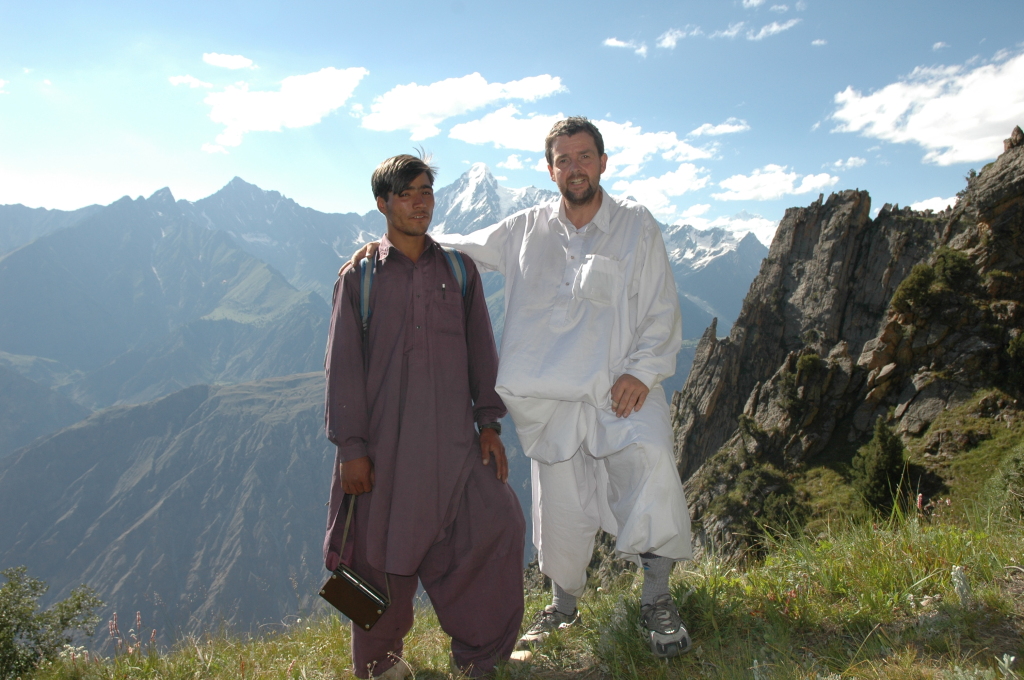 Peter Lyckberg with his brother, Asim, who is a miner at the Dusso-Haramosh pegmatites in Pakistan.
Peter Lyckberg with his brother, Asim, who is a miner at the Dusso-Haramosh pegmatites in Pakistan.
These pegmatites have yielded aquamarine, topaz, fluorapatite, fluorite, schorl, herderite,
spessartine garnet and other fine mineral specimens. Peter Lyckberg photo, 2005.
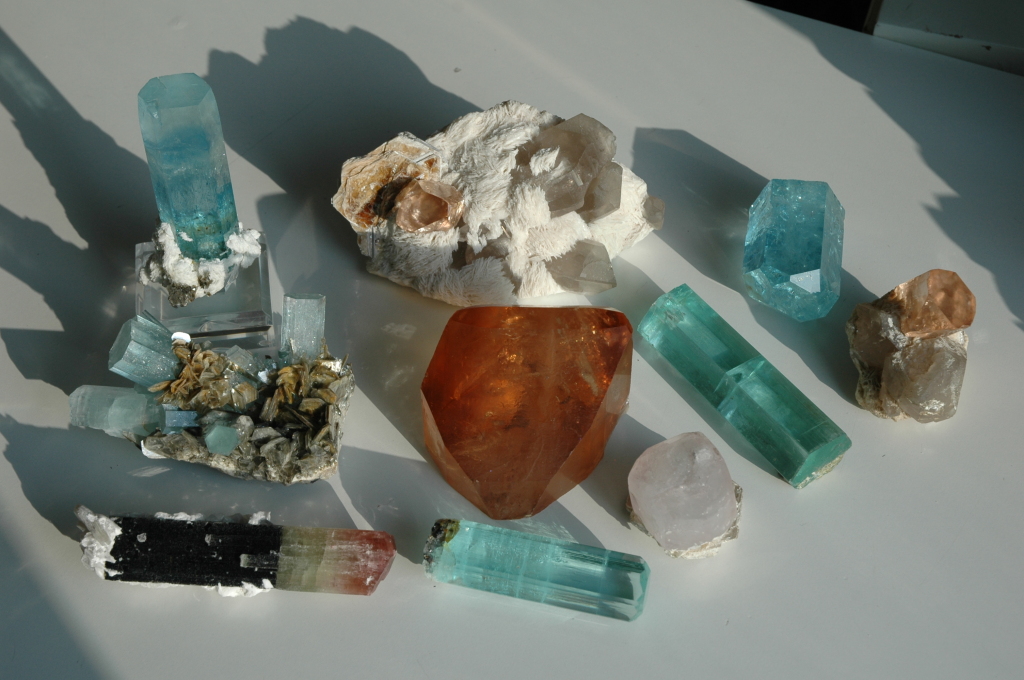 Gem crystals (stunning!) from Pakistani pegmatites, August 2005 – Feb 2006, including aquamarine, topaz and elbaite tourmaline.
Gem crystals (stunning!) from Pakistani pegmatites, August 2005 – Feb 2006, including aquamarine, topaz and elbaite tourmaline.
The large deep-golden topaz in the centre is 10cm tall – both the topaz and the aqua at the upper left are from Haramosh, Dusso (preceding photo).
On the left, the aqua group with muscovite in the middle from Chumar Bakhoor meausres 15 cm.
Peter Lyckberg collection and photo.
One observation of Peter’s rings so true with my own experience (as you may have read in other posts on the website) – fine mineral specimens are so rare, even from the most famous localities. Hundreds and even thousands of people can search a locality or region every day, all year, with very little found by anyone over the course of a whole year, let alone during a more targeted visit to a region or locality. Fine mineral specimens are truly to be appreciated and treasured, as mining them and producing them is long, hard work, almost always with very little or nothing to show for it.
On Friday morning, Dr. Carl Francis (former curator of the mineral collection at Harvard University) spoke about a remarkable project in Maine. Many of us know of the pegmatites of Maine, famous finds of tourmaline, beryl, purple fluorapatite and many other superb mineral specimens. Lots of these specimens grace collections all over the world. Which is great, in a way. But Larry Stifler and Mary McFadden, a dedicated, conservation-minded couple in Maine, determined that it was time to have a top collection of these finds in a museum in the heart of the pegmatite district in Maine. They assembled a team and they have supported the construction and development of The Maine Gem and Mineral Museum in Bethel, and the effort has included the building of a collection, to acquire and indeed repatriate many fine Maine specimens. This is an amazing endeavour, and the museum is a project that has grown by leaps and bounds since it was conceived (with a recent addition of lab equipment and a team of researchers led by none other than famous pegmatite expert Skip Simmons, with Karen Webber and Al Falster). It will surely make for a great visit – currently anticipated to open in summer 2016.
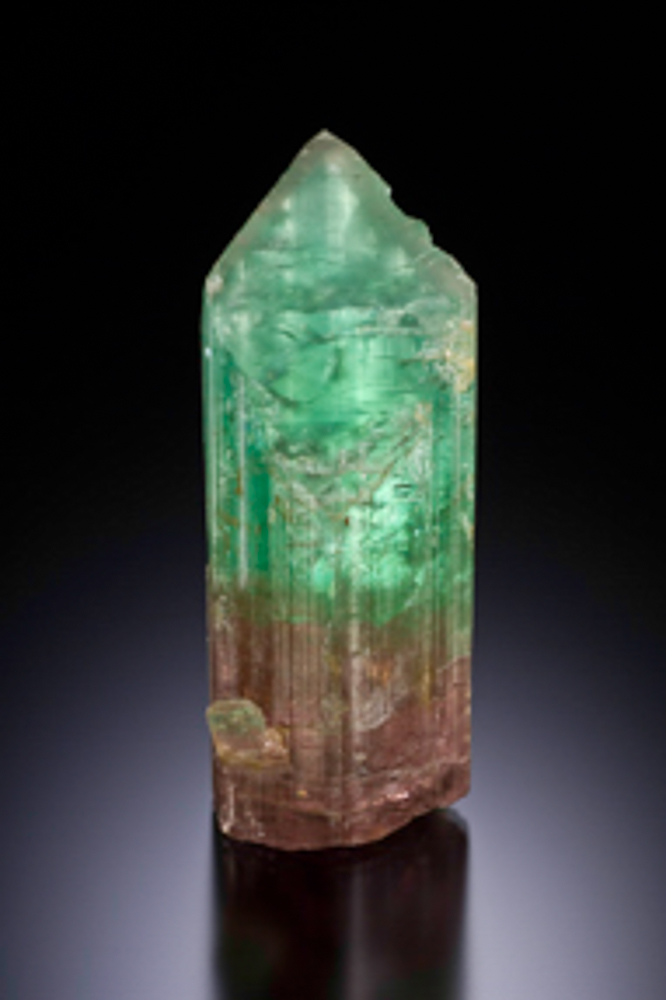
Elbaite Tourmaline, Dunton Quarry, Newry, Oxford Co., Maine.
From the famous 1972 find, from the Raymond G. Woodman collection.
Jeff Scovil photo.
Cut stones from the Mount Marie Quarries, Paris, Oxford Co., Maine.
Mined by Dennis Durgin in 2011.
Jeff Scovil photo.
Our next speaker, Herwig Pelckmans, took us overseas, to the minerals of Belgium. This was a great topic – most of us know so little about Belgian minerals, when in fact the type localities for no fewer than 18 minerals are in Belgium (willemite and hopeite might be the most often recognized of these, and the list also includes cool phosphates and arsenates, among others). Herwig’s presentation included many fine photographs contributed by several collectors/photographers and was rather mind-expanding – we all end up becoming used to the minerals we see most often at mineral shows, and so a glimpse into this was great! Here are a couple of examples of just one mineral, ardennite-(As):
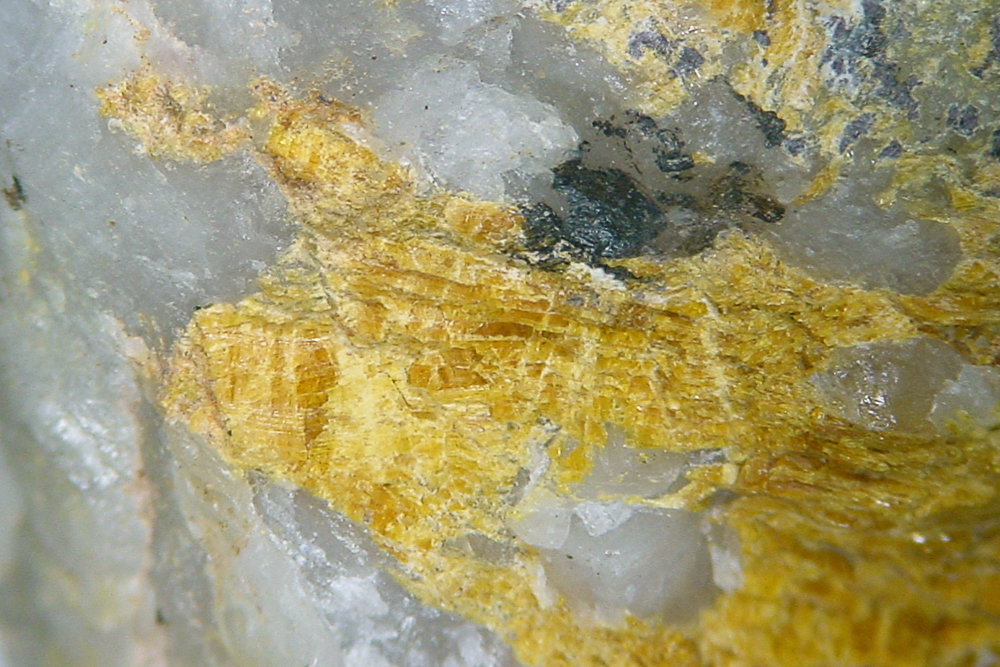 Ardennite-(As), Salmchâteau, Vielsalm, Luxembourg Province, Belgium (type locality) – field of view 15mm
Ardennite-(As), Salmchâteau, Vielsalm, Luxembourg Province, Belgium (type locality) – field of view 15mm
Paul Mestrom collection and photo.
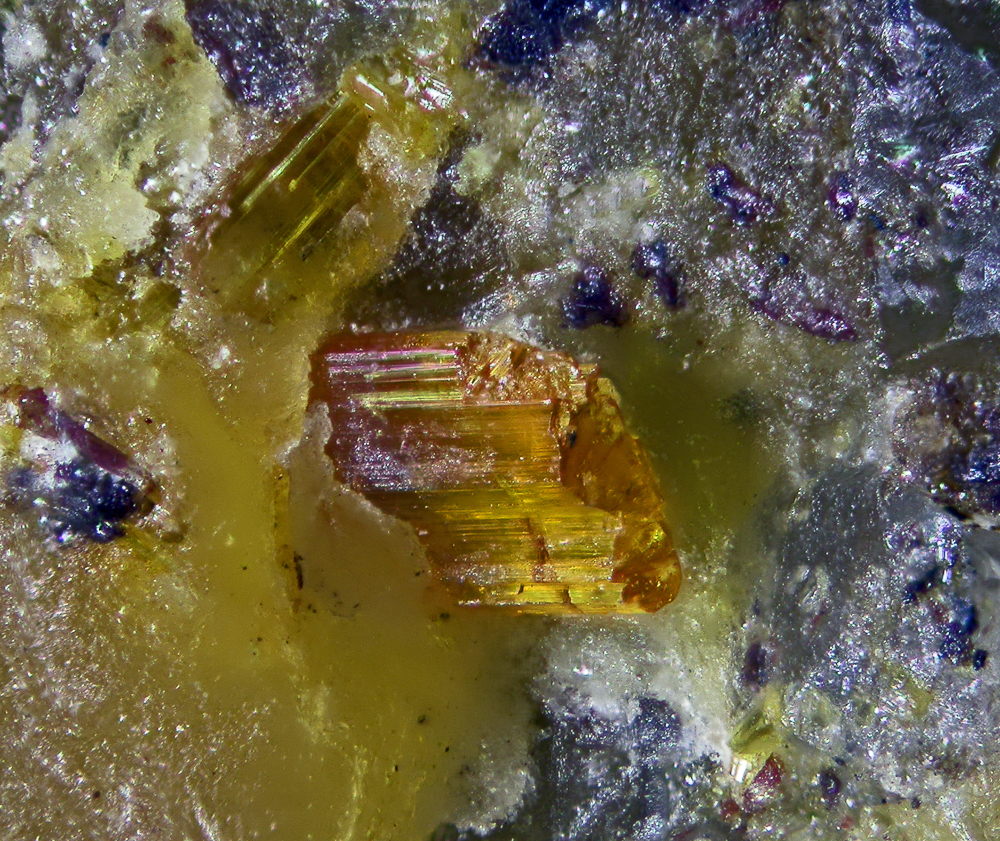 Ardennite-(As), a rare free-standing euhedral crystal, Salmchâteau, Vielsalm, Luxembourg Province, Belgium (type locality) – field of view 1.55 mm
Ardennite-(As), a rare free-standing euhedral crystal, Salmchâteau, Vielsalm, Luxembourg Province, Belgium (type locality) – field of view 1.55 mm
Ko Jansen collection and photo.
Herwig’s presentation also featured Belgian mineralogists and their contributions to mineralogy – notably with respect to minerals first described from the deposits at Shinkolobwe, Lubumbashi and others in the Democratic Republic of the Congo. Of the many, cornetite is perhaps the best known. (More on some others below – Herwig’s second presentation of the Symposium gave further insight!)
After Friday afternoon’s Technical Session (see below), Jeff Scovil presented on his return trip to Madagascar – of course, with many great photos. Including many cool non-mineral photos. Heaven forbid!
Would love to know what this lemur is saying…
 Ring tailed lemurs in Isalo Park, Madagascar. Jeff Scovil photo.
Ring tailed lemurs in Isalo Park, Madagascar. Jeff Scovil photo.
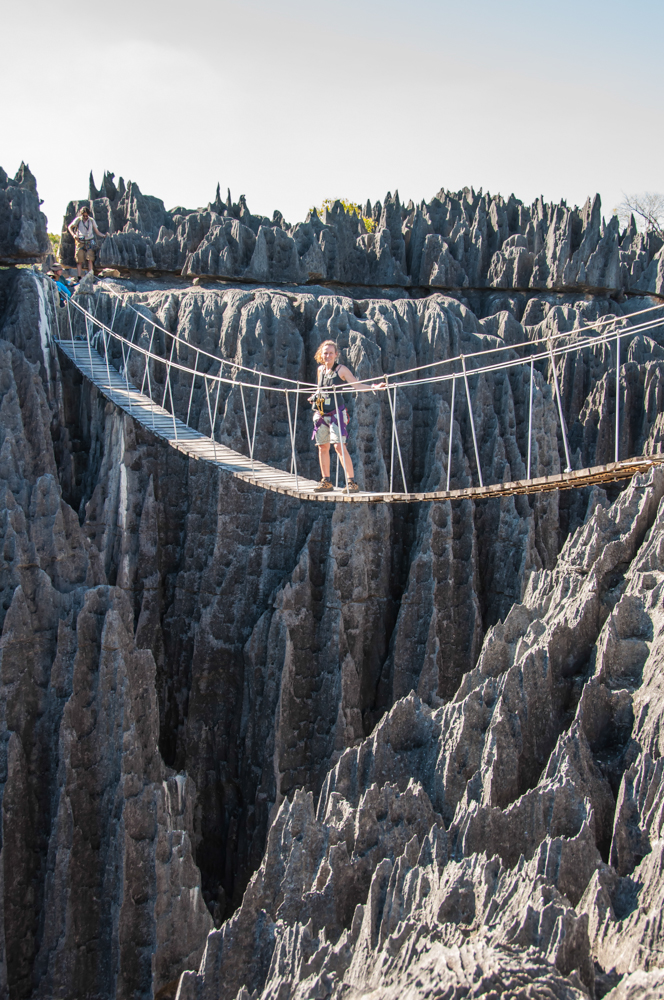 Bridge in Tsingy Bemaraha Park, Madagascar. Leslie Watson in centre. Jeff Scovil photo.
Bridge in Tsingy Bemaraha Park, Madagascar. Leslie Watson in centre. Jeff Scovil photo.
We were incredibly fortunate to have a new presenter speaking on Friday night, Dr. Alex Schauss, one of the world’s pre-eminent collectors of thumbnail-sized specimens. He shared photographs of some of his brilliant specimens, and with eye-candy like those, who needed dessert?! Along with Alex’s great stories, they made for a memorable talk.
Alex’s love for minerals began with collecting minerals from Manhattan construction sites, and was fostered by none other than Dr. Frederick Pough, with whom he visited often at the American Museum of Natural History. (What a tutor to have, as a young collector!) Alex’s field-collecting career has involved some rather famous localities, including the Kelly Mine in New Mexico, Broken Hill, Australia and the Rowley Mine in Arizona, and for a taste of the specimens he shared, we’ll start with a specimen he collected in 1980 on a trip to Broken Hill. In Alex’s own words:
It was Albert Chapman who suggested I take the 490 km trip to Broken Hill and see what I could find on the dumps. This specimen was caked by a layer of clay, but because it showed some evidence of morphology, I put it in my pocket just as I was leaving the mine after finding little of interest and later dropped it into a glass filled with water at a “1/2 star hotel” in Broken Hill. The photo shows you what it looked like the next morning before heading back to Sydney, eager to show Albert the find. This specimen was included in both my winning McDole Trophy (1989)and Desautels Trophy (2010) exhibits of thumbnail specimens in 2010.
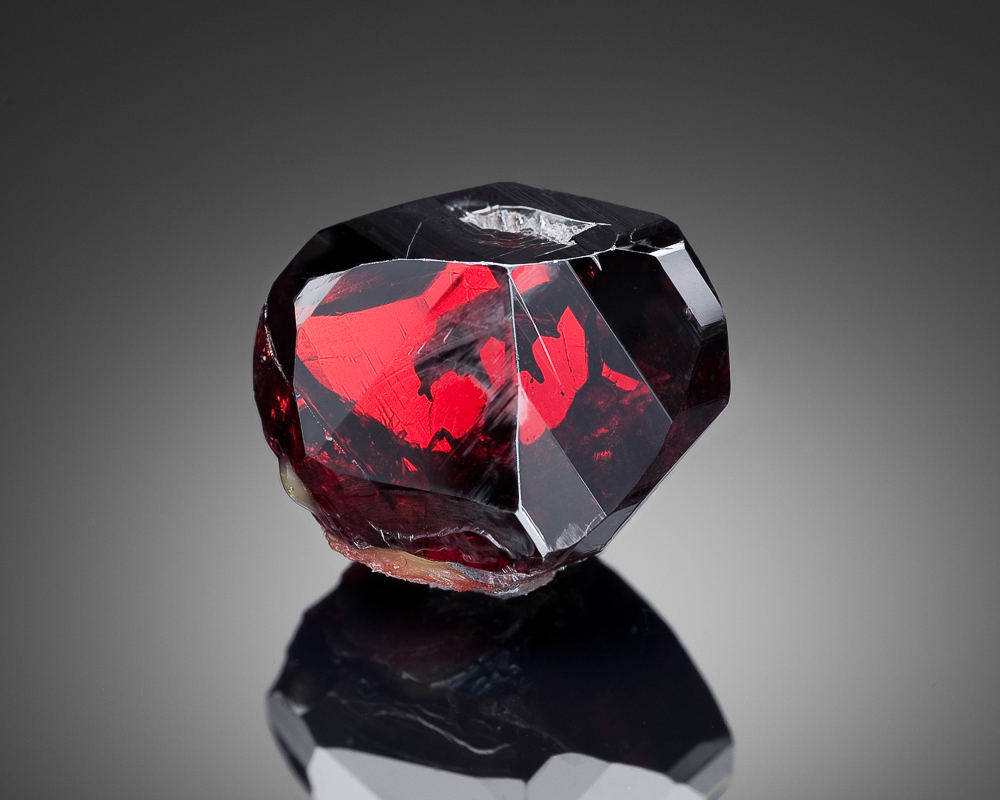 Spessartine garnet, Broken Hill, New South Wales, Australia. Personally collected by Alex Schauss and in his collection – 2.0 cm.
Spessartine garnet, Broken Hill, New South Wales, Australia. Personally collected by Alex Schauss and in his collection – 2.0 cm.
Mark Mauthner photo.
A couple other specimens from Alex’s collection:
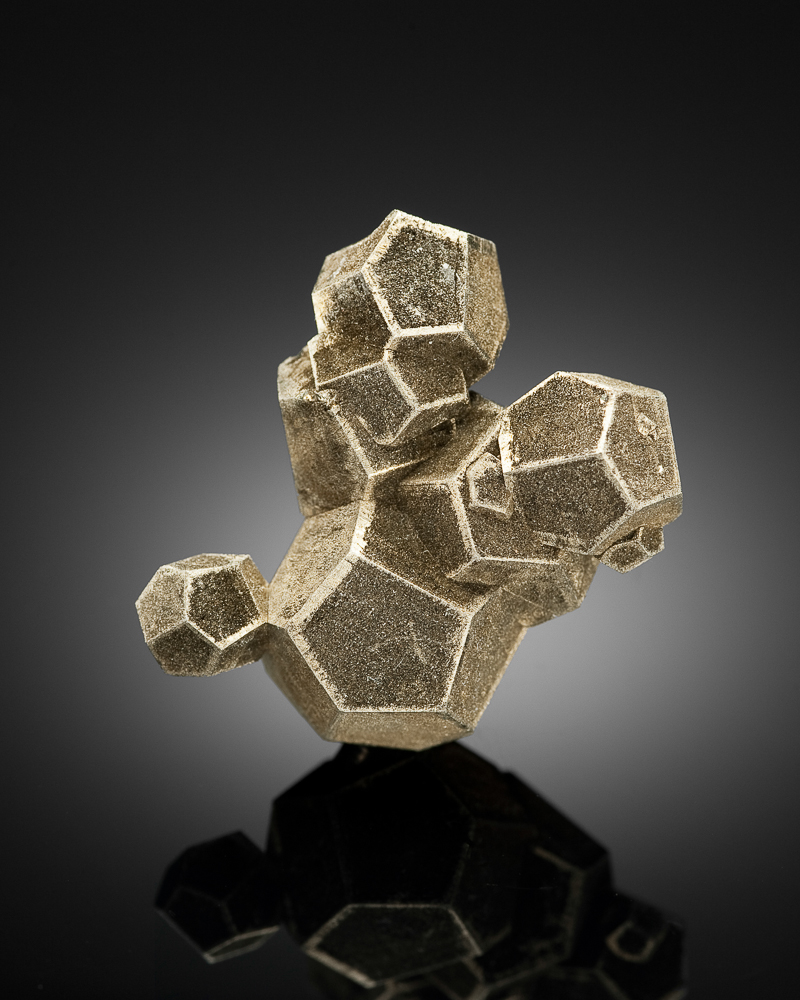 Pyrite, Ground Hog Mine, Gilman, Eagle County, Colorado, Alex Schauss collection – 2.7 cm.
Pyrite, Ground Hog Mine, Gilman, Eagle County, Colorado, Alex Schauss collection – 2.7 cm.
Mark Mauthner photo.
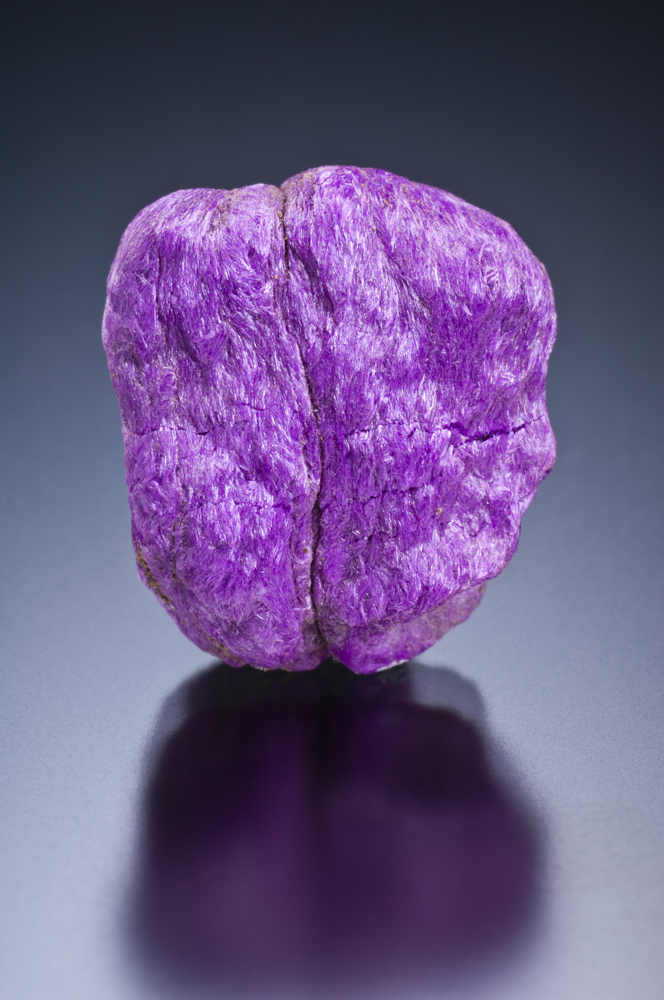 Sugilite (fibrous), N’Chwaning II Mine, from discovery pocket (Nov 2013), Alex Schauss collection – 1.7 cm.
Sugilite (fibrous), N’Chwaning II Mine, from discovery pocket (Nov 2013), Alex Schauss collection – 1.7 cm.
Jeff Scovil photo.
On Saturday morning, Dr. Christopher Stefano presented The Life and Collection of Eberhardt W. Heinrich. Chris is the associate curator of the A.E. Seaman Mineral Museum at Michigan Tech University, the official mineral museum of the state of Michigan and widely regarded as one of North America’s finest mineral museums. Eberhardt “Abe” Heinrich was a professor of geology at the University of Michigan from 1947 to 1983, who, among other achievements, produced 135 publications and eight books, while running a significant research program.
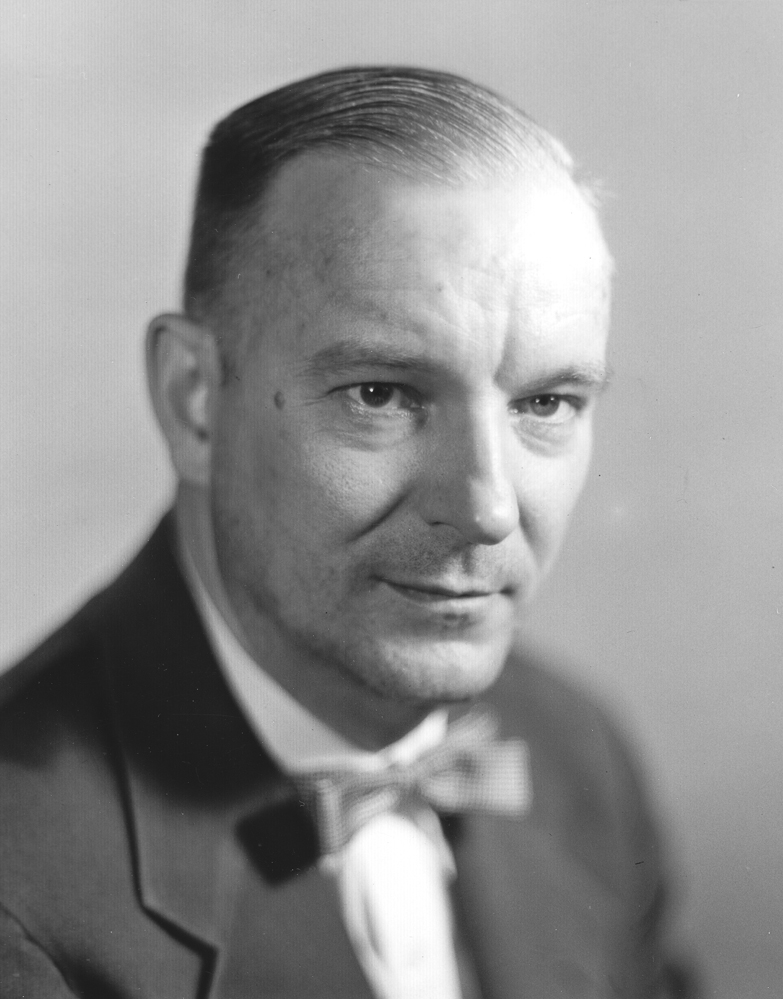 Eberhardt W. Heinrich, photo date and photographer unknown.
Eberhardt W. Heinrich, photo date and photographer unknown.
Heinrich assembled a large personal mineral collection (approximately 15,000 specimens) which he donated to the A.E. Seaman Mineral Museum – specimens from his collection are on display there. Although he does have a mineral named in his honour, heinrichite is perhaps not the most visually compelling of minerals, and Chris and I thought you might prefer three specimens from his collection that are interesting and aesthetic (this collection includes some amazing specimens!).
This first one is an unusual tapered and stepped quartz crystal, which Heinrich likely acquired during his World War II exploration efforts with the U.S. Geological Survey, working in the Appalachian Mountains.
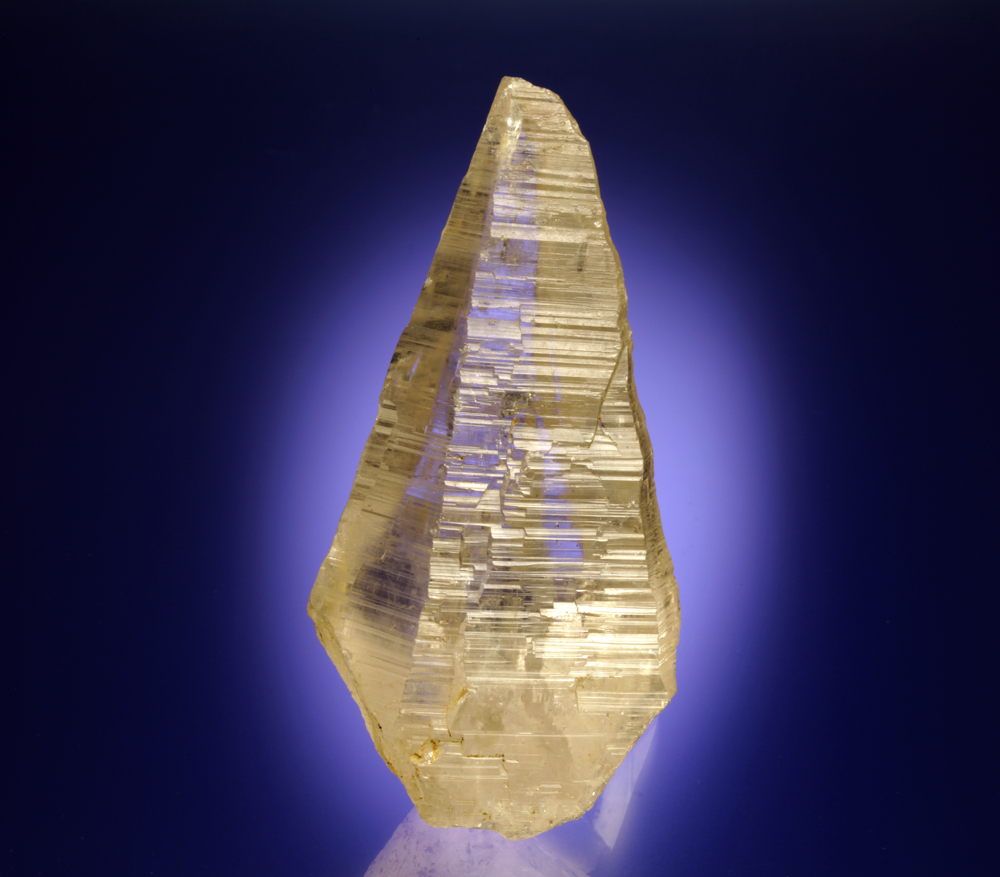 Quartz, F. W. Hamrick property, Shelby, North Carolina – 11cm.
Quartz, F. W. Hamrick property, Shelby, North Carolina – 11cm.
A.E. Seaman Mineral Museum collection. Chris Stefano photo.
This next one from Franklin is superb, among the rarest and finest specimens in the Heinrich collection:
Graphite spheres, Franklin, Sussex Co., New Jersey – 9 cm.
A.E. Seaman Mineral Museum collection. Chris Stefano photo.
And from the superb to the outright astounding, this is one of the largest and finest crystals (possibly _the_ largest and finest crystal) of kainosite-(Y) known. This is from a Bancroft Area mine which was not known for fine mineral specimens.
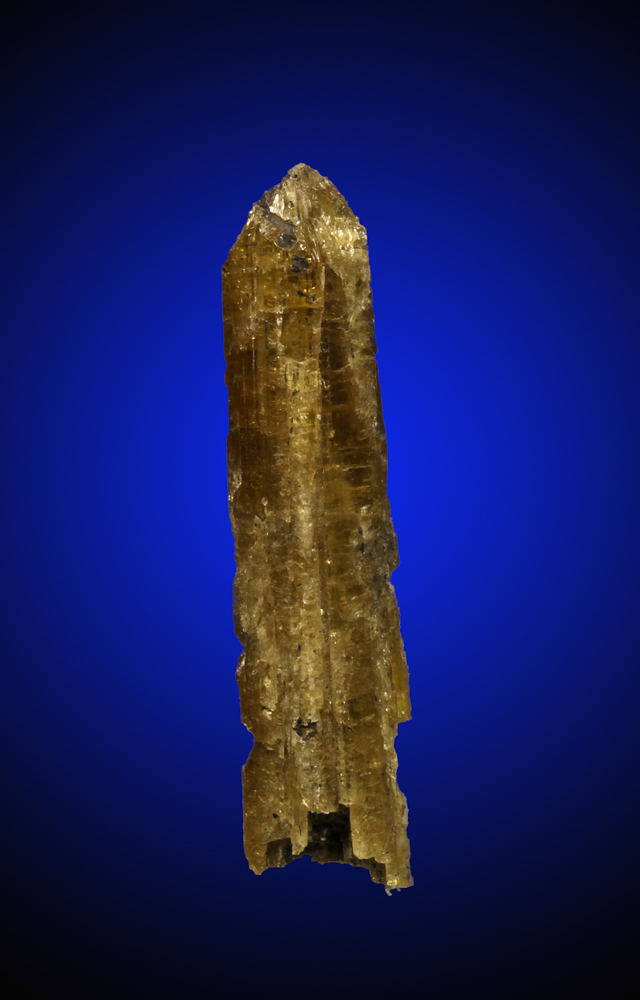 Kainosite-(Y), Bicroft Mine, Highlands East, Haliburton Co., Ontario – 3.5 cm
Kainosite-(Y), Bicroft Mine, Highlands East, Haliburton Co., Ontario – 3.5 cm
A.E. Seaman Mineral Museum collection. Chris Stefano photo.
Saturday’s afternoon presentations began with me, and “Into the Andes – Quiruvilca, Peru”. This talk was inspired by a joint trip and project with my good friend and collecting partner David Joyce (David K. Joyce Minerals).
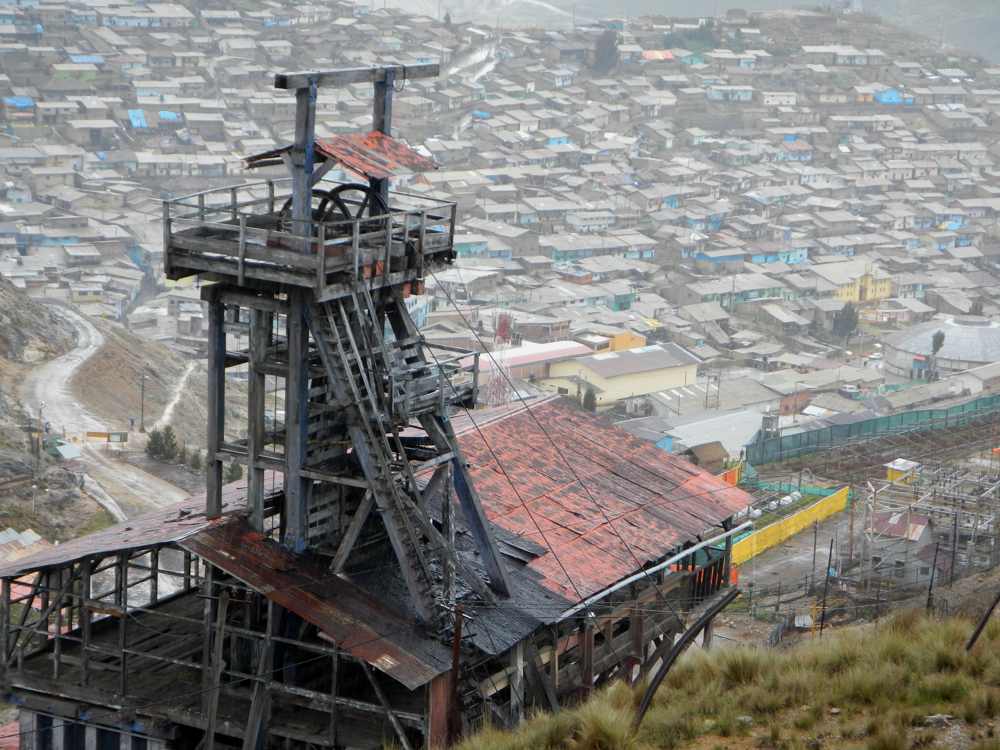 Headframe at the Elvira Shaft, Quiruvilca, Peru. R. McDougall photo.
Headframe at the Elvira Shaft, Quiruvilca, Peru. R. McDougall photo.
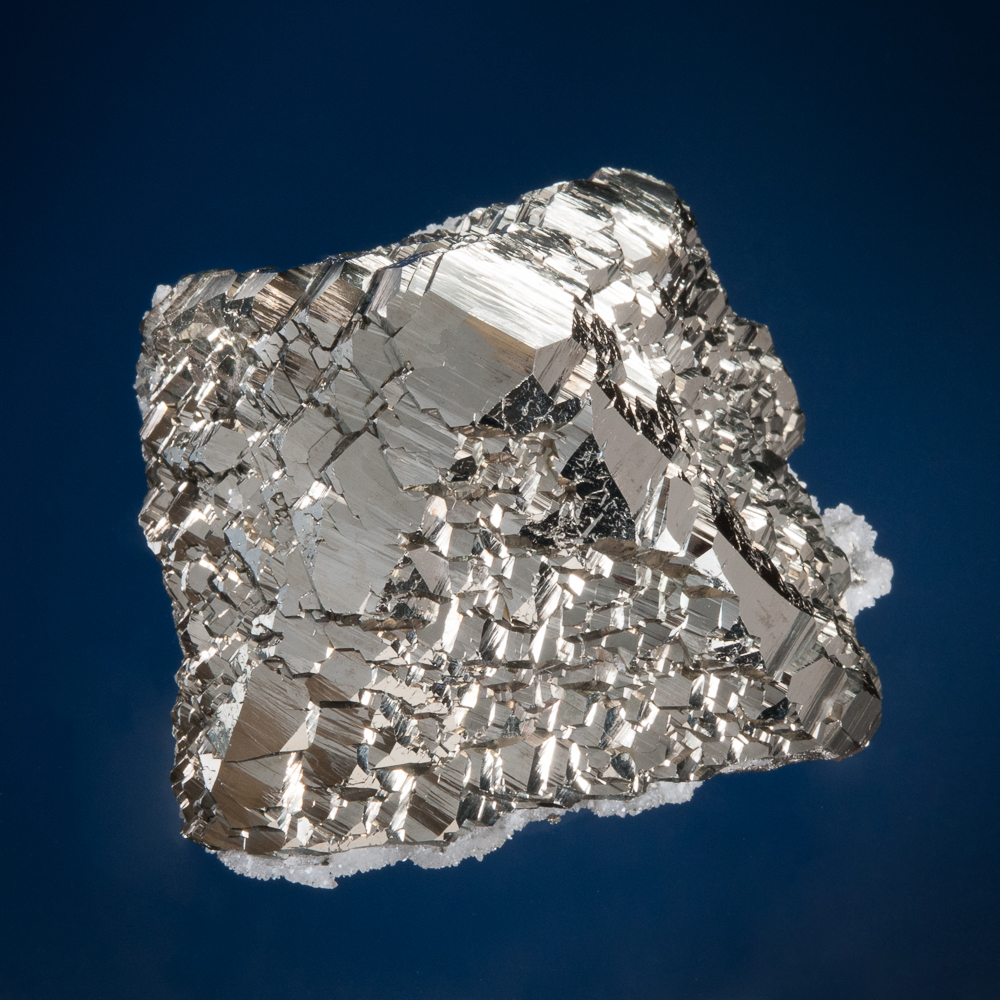 Pyrite (pyritohedral crystals over an octahedron), Quiruvilca, La Libertad Dept., Peru – 8cm.
Pyrite (pyritohedral crystals over an octahedron), Quiruvilca, La Libertad Dept., Peru – 8cm.
R. McDougall specimen and photo.
The link to the original adventure (on this website) is under Links and References at the end of this post. For Rochester, the original presentation was expanded, thanks to the generous contributions of others, with stories and photographs of Quiruvilca specimens – my sincere thanks to Jaroslav Hyrsl for encyclopedic knowledge and photos of excellent specimens, John Betts for great photos, Rock Currier for fun stories and photos, and Tony Peterson, a Canadian collector who is taking some amazing mineral photographs these days. (Important note: All full-length presentations at Rochester dating back to 1987 have been recorded and are available on DVD – details are below under Links and References.)
Saturday’s last talk was by Kim Tait, the Teck Chair of Mineralogy at the Royal Ontario Museum (the ROM) in Toronto. Kim spoke about some of the most recent projects in minerals at the ROM, including renovation of the mineral collection areas underground, and the story of the recent acquisition of the 22,000-specimen Kirwin Collection. The Kirwin Collection was housed in Bangkok, Thailand. Some logisitcal challenge to be sure, but it might not sound like the toughest challenge for minerals, distance and volume of specimens aside… except… do you remember massive Bangkok floods in the news in recent years? Although not in anyone’s plans, this project involved a surprise mission when Kim got a phone call not long after the arrangements were settled: the floods were bad and this effort would include saving the collection from rising floodwaters.
The Kirwin Collection includes a significant number of ore assemblages from remote and unusual localities, and strong suites of minerals from southeast Asia.
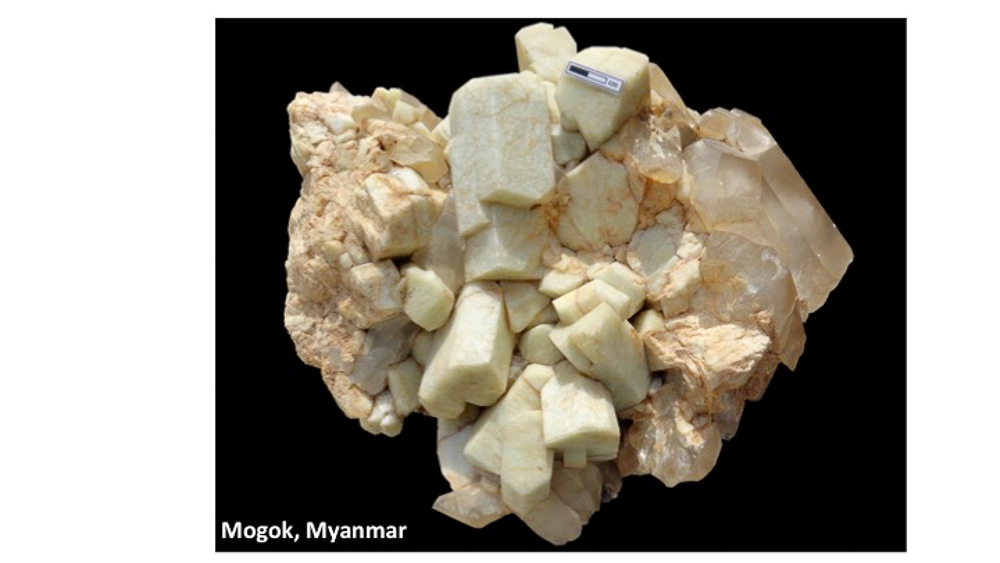
Microcline with Quartz, Mogok, Myanmar – cm-bar for scale. Kirwin Collection, ROM specimen and photo.
And this one is simply mind-boggling:
Clinohumite, Vietnam – crystal 7 cm. Kirwin Collection, ROM specimen and photo.
OK, let’s face it. It’s not easy getting up on Rochester Sunday morning. By now we’ve been up late with mineral friends on the fourth floor, into the morning hours, for three nights running. But this year – as with last year – we had great Sunday morning attendance.
Our Sunday morning talks justified the effort required to emerge from that pending coma… as we had a reprise from each of Herwig Pelckmans and Peter Lyckberg.
Herwig led off with “SCHOEP: From Fred Flintstone to Bob the Builder”. One of Belgium’s most important mineralogists, Professor of Mineralogy at the University of Ghent, Belgium for many years, Alfred Shoep (1881-1966) described 19 minerals new to science, of which 15 are still valid today. Schoepite, Paraschoepite and Metaschoepite are named after him. When access to the uranium deposits of the Democratic Republic of the Congo (formerly Belgian Congo) became possible, Schoep became involved in describing new species, primarily radioactive species from Shinkolobwe, Kasolo and Kalongwe.
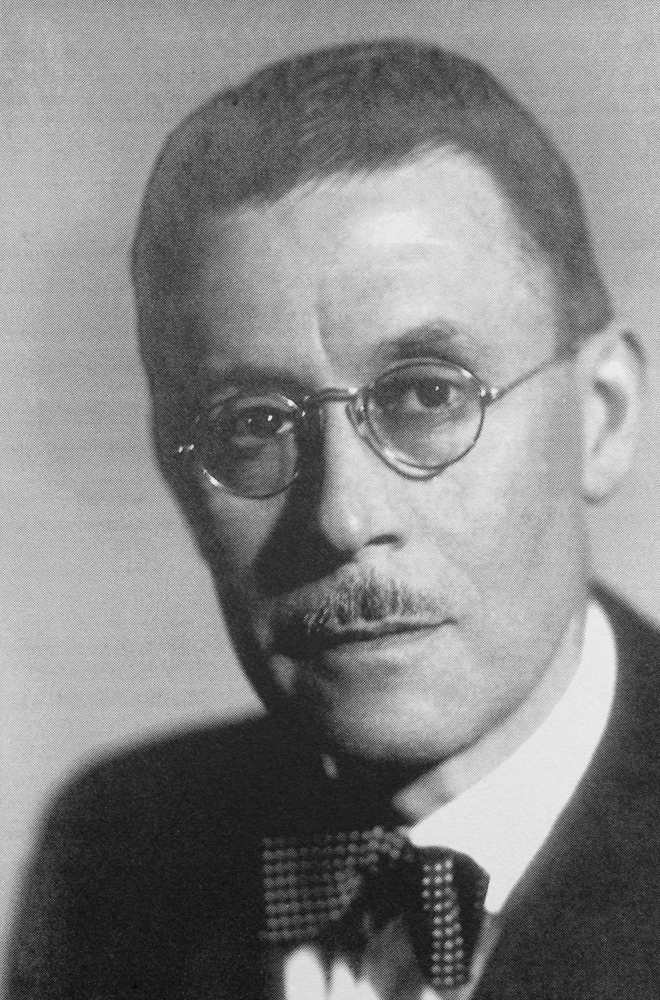 Belgian Mineralogist Alfred Schoep (1881-1966). Date of photo and photographer unknown.
Belgian Mineralogist Alfred Schoep (1881-1966). Date of photo and photographer unknown.
In 1921, a specimen of gummite was shown to Schoep by his friend and colleague Jules Cornet (after whom cornetite is named), and it was that gummite specimen that sparked Schoep’s interest in radioactive minerals. The inspiring gummite was similar to this one – I know you can’t see radioactivity, but this thing really looks the part:
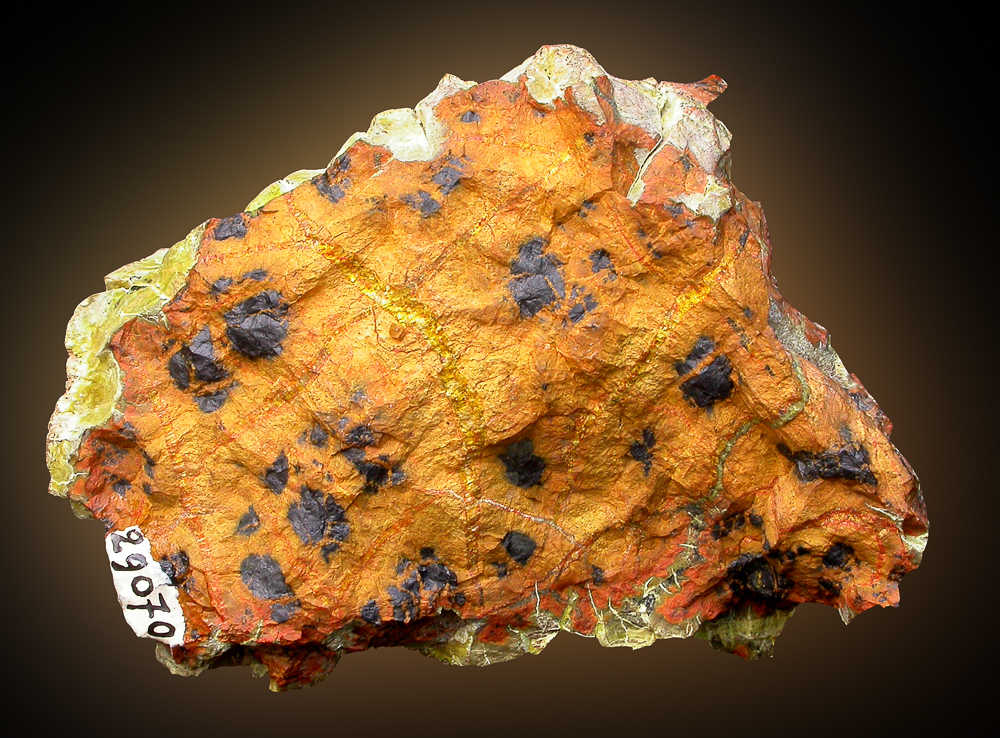 Gummite, Luiswishi Mine, Lubumbashi, Katanga Copper Crescent, Katanga, Democratic Republic of the Congo.
Gummite, Luiswishi Mine, Lubumbashi, Katanga Copper Crescent, Katanga, Democratic Republic of the Congo.
Field of view 6.4 cm.
Paul De Bondt collection and photo (2008).
One of the minerals Schoep described was parsonsite, and the naming is interesting. In his mineralogy career, Schoep had good connections with Canada. In 1923 Thomas Walker, of the University of Toronto, had described a new radioactive mineral from Kasolo (Katanga) and named it schoepite. Later that same year, Schoep described another new radioactive mineral from Kasolo and named it parsonsite, in honor of Arthur Leonard Parsons (1873-1957), Professor and Head of Mineralogy and Petrography at the University of Toronto (1936-1943).
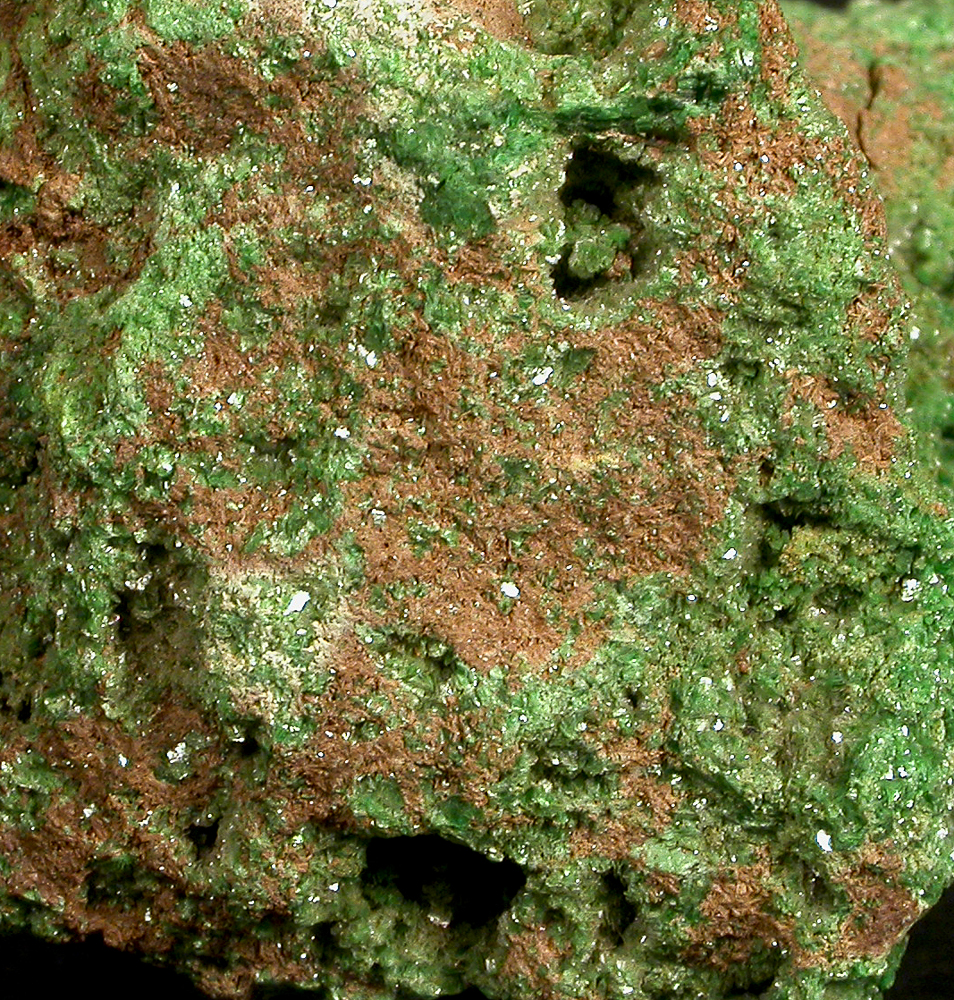
Parsonsite, Kasolo Mine, Shinkolobwe, Katanga Copper Crescent, Katanga, DRC – field of view 2.4 cm.
Paul De Bondt collection and photo (2008).
As for Herwig’s mysterious reference to Bob the Builder, Schoep’s legacy extended well beyond the world of minerals.
[Wait – IS there anything beyond the world of minerals?]
After Schoep became a senior figure within the administration at the university, he led a huge program that saw the construction of many buildings that remain iconic for the town of Ghent.
For our grande finale, we were treated to one more series of Peter’s adventures, this time at the Malmberget Mine, Lappland, Sweden. (I describe it as a “series” because Peter’s collecting and documentation of the deposit and specimen mineralogy at Malmberget was a patient and sustained effort over an extended period of time.) The Malmberget iron mining complex is huge, with interesting and varied mineralogy – it is one of the world’s largest underground mines. The infrastructure includes underground highways, underground workshops, an underground restaurant, phone and internet.
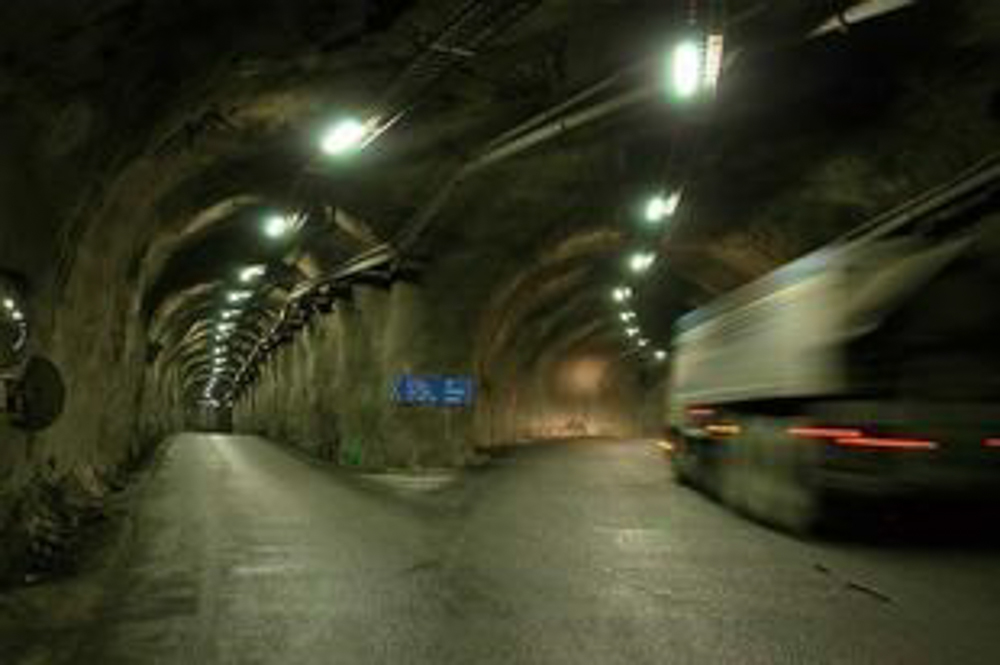 Underground highway system in the Malmberget Mine, Lappland, Sweden. LKAB Mining Company photo.
Underground highway system in the Malmberget Mine, Lappland, Sweden. LKAB Mining Company photo.
The deposit is such that pockets are not uncommon, but of course, as always, fine mineral specimens are incredibly rare. Peter estimated that in his 20 years of study of, and visits to, the Malmberget Mine, thousands of pockets have been found. And yet, most do not contain fine crystals of anything, and some that did contain specimen material collapsed, or were otherwise damaged. Nonetheless, these efforts are all about those very rarest of occasions where incredible specimens can be found. In December 1988 and January 1989, Peter’s persistence and work paid off in what is now a well-known discovery of incredible golden calcite crystals. These calcite crystals reached up to 10-20 cm, and included single crystals and even a few butterfly twins.
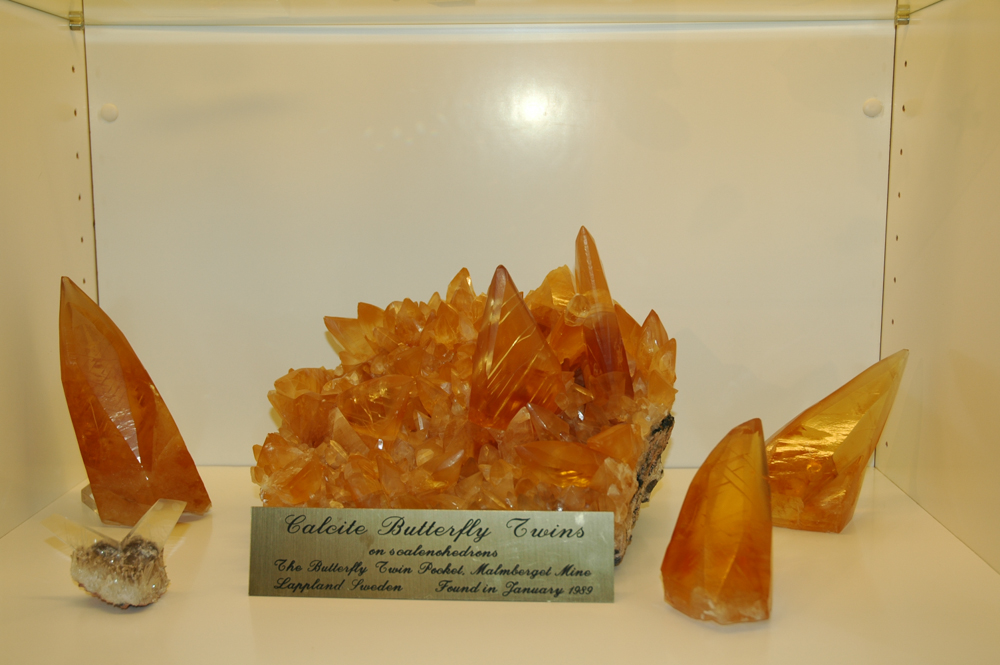 Calcite, Malmberget Mine, Lappland, Sweden – central specimen 25 cm.
Calcite, Malmberget Mine, Lappland, Sweden – central specimen 25 cm.
Peter Lyckberg collection and photo.
Although this part of the Malmberget Mine has now collapsed and the mining has gone deeper where specimens and pockets are much rarer, it is fortunate that this incredible pocket was collected and that such excellent specimens were preserved. The stories in Sunday morning’s presentation were super. (Peter has written about the calcite pocket story on mindat – the link is below, under Links and References).
Technical Session
Every year, Friday afternoon of the symposium is reserved for the technical session. This session is a packed afternoon, with talks strictly limited to 15 minutes. Abstracts from these talks are included in the symposium program, and they are also published during the year in Rocks and Minerals magazine, so keep an eye out for them!
Annual “What’s New”
Saturday morning always features Jeff Scovil presenting What’s New in Minerals and Localities. Jeff’s superb photography takes us around the world for an hour, as he covers finds from the past year. Some of these are photographs that we see in the mineral periodicals during the year, and other photographs may make their debut at Rochester – Jeff never fails to draw gasps, oohs and ahs, as he shows beautiful photographs of exquisite specimens. Here are just a couple:
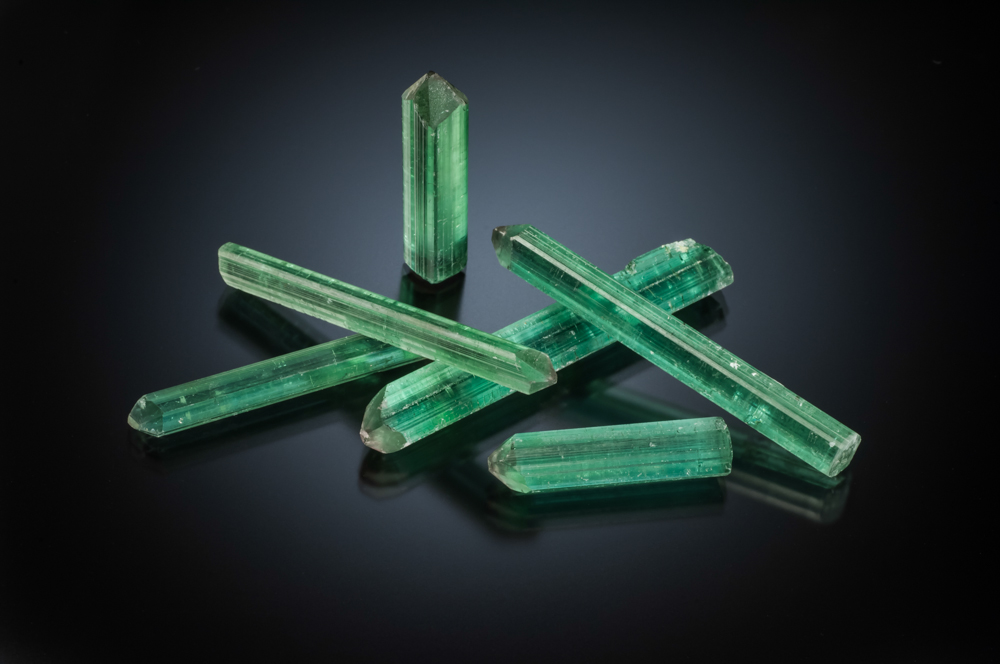 Elbalite Tourmaline, Havey Mine, Poland, Maine – up to 5.6 cm
Elbalite Tourmaline, Havey Mine, Poland, Maine – up to 5.6 cm
Maine Mineral & Gem Museum specimens, Jeff Scovil photo.
Paracoquimbite, Xitieshan, Qinghai, China – 5.9 cm
Steve Smale collection, Jeff Scovil photo.
Jeff is the master! If you would like him to photograph your minerals, or you are looking for mineral photos for a publication, his website under Links and References. More and more of his catalogue is becoming searchable online. Now we can ooh and aah any time…
Following Jeff, What’s New in Minerals and Localities II is the chance for short contributions from other symposium registrants. This is an hour that just comes together as it does, in the moment – sometimes full and other times only a couple of contributions. We never know!
This was a quieter year, with only two presenters.
Ruth Debicki, from Sudbury, Ontario, introduced the new online resource “GeoTours Northern Ontario”. Geoscientists from Natural Resources Canada’s Geological Survey of Canada, Ontario Geological Survey, Dynamic Earth science centre and Laurentian University have created a site full of the stories of Northern Ontario’s geology, to inspire visitors. Tours are posted online with facts and photos, so you can do some virtual touring until you can no longer withstand the urge to see it all in person! See Links and References.
I also presented briefly on some of the year’s mineral finds – if you’ve been following the website, they will seem less new to you, as there are lots of photos on the website. I highlighted some of what struck me as the most striking new finds I’ve come across over the past year, including the German anhydrite and probertite crystals, the Mali yellow stilbite balls, the Volodarsk goethites, the, the N’Chwaning inesites, and the Mundo Nuevo tetrahedrites .
Displays
Each year the Symposium features displays of some superb minerals, some by individual collectors and some by institutions. This year, a few individuals had some particularly remarkable specimens on display – here are just a few.
Canadian collector George Thompson always puts on a great display – this year’s was no exception, with Yukon phosphates including a killer bobdownsite (top, centre) – and that’s a vivianite from Big Fish River in the centre (approx 5cm).
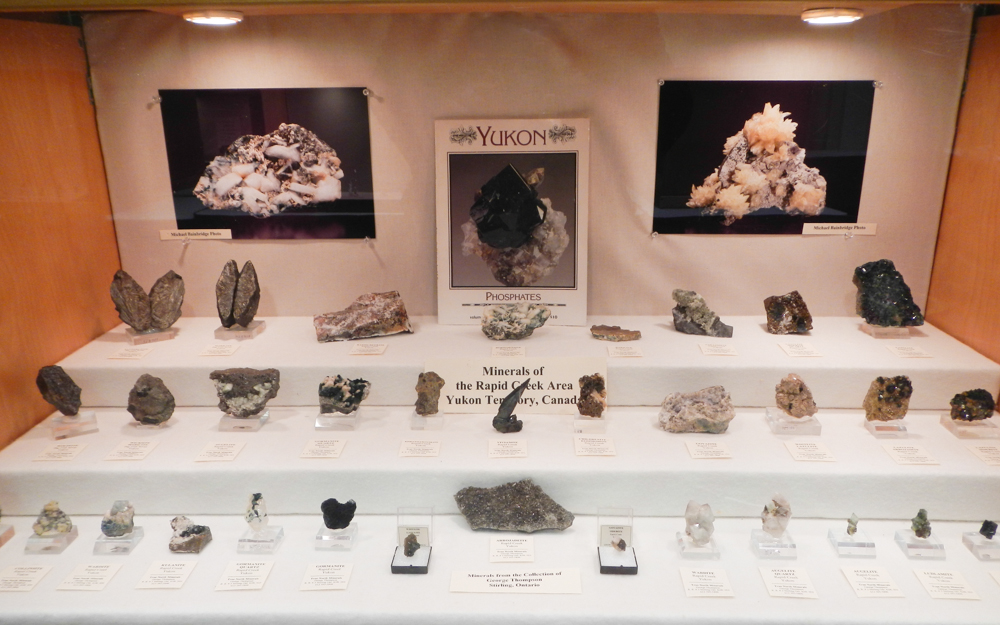 Minerals of the Rapid Creek Area, Yukon, Canada – great case from George Thompson. Many exceptional rarities!
Minerals of the Rapid Creek Area, Yukon, Canada – great case from George Thompson. Many exceptional rarities!
Well-known Montreal-area collector, Jonathan Levinger, brought a case entirely featuring serandite from Mont St. Hilaire from various finds over the years.
A deep orange serandite with manganoneptunite and analcime – approx 4cm. Jonathan Levinger collection.
Jeff Morrison’s display of minerals from mining at the Havey Mine near Poland Maine was super.
Minerals from the Havey Mine, near Poland, Maine, featuring beautiful elbaite tourmaline crystals.
Jeff Morrison collection.
John Betts puts in great displays and this year’s, from New England and New York included excellent specimens classics localities like Rossie, NY, to more recent unusual localities like this one:
Sharp, lustrous amethyst crystals from a Massachusetts housing development excavation area about 15 years ago – 8 cm.
John Betts collection.
Terry Huizing’s case always includes stunning specimens…
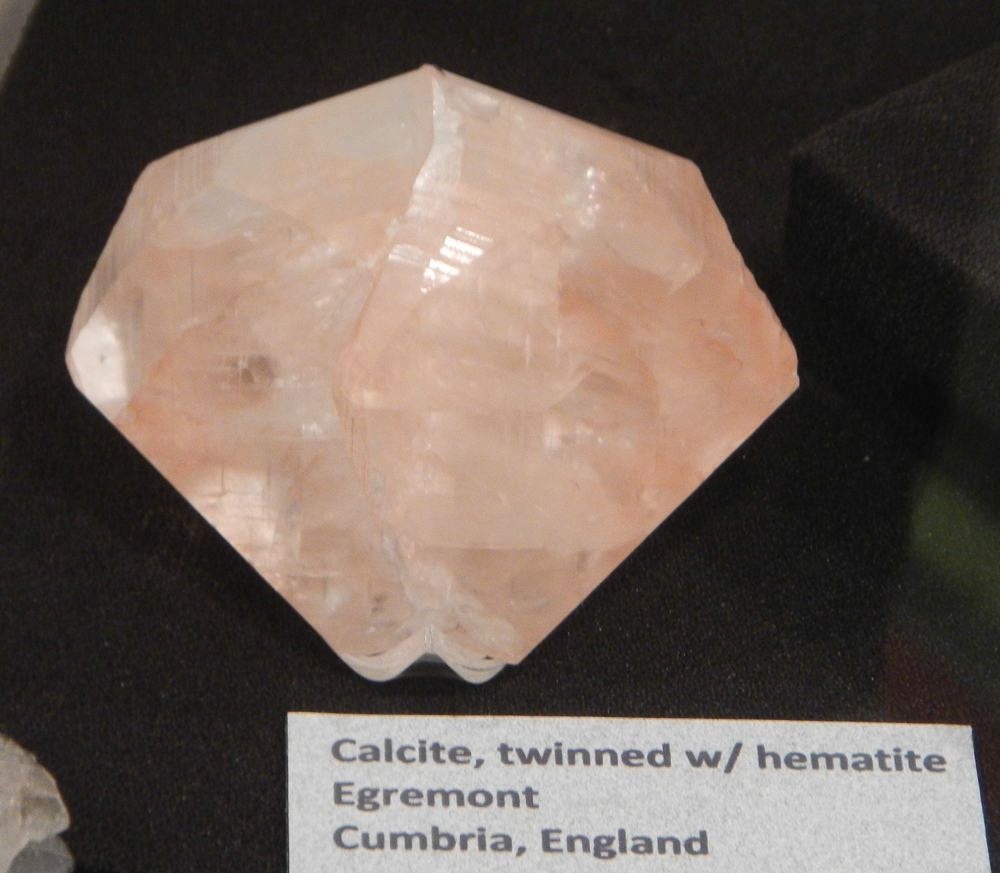 Classic heart-twinned English calcite – approx 7 cm. Terry Huizing collection.
Classic heart-twinned English calcite – approx 7 cm. Terry Huizing collection.
And I thought this was a remarkable specimen of the sharp, lustrous magnetite from Bolivia:
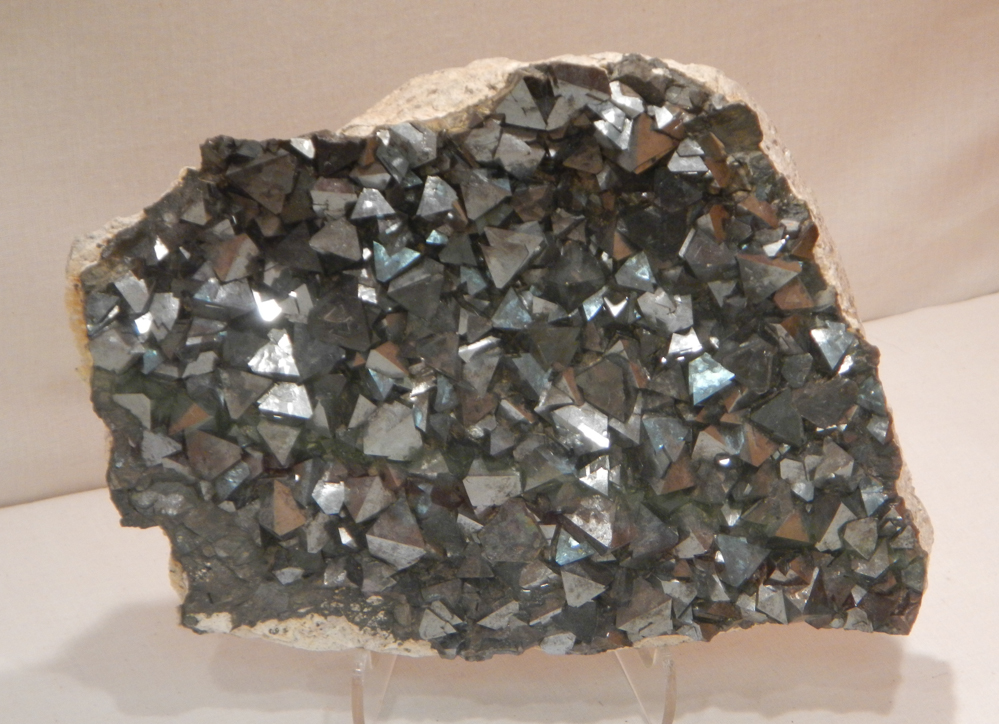 Magnetite, Cerro Huanaquino, Potosi, Bolivia – approx 25 cm. Diane Francis collection.
Magnetite, Cerro Huanaquino, Potosi, Bolivia – approx 25 cm. Diane Francis collection.
The Fourth Floor
Much of the Rochester experience simply can’t be written, nor does it easily lend itself to photographs. Not because it’s bad (ok fourth floor late night Topaz Bowling could be viewed by some as bad), but because it’s about hanging out and sharing stories and laughs in rooms and hallways, not to mention sharing nice wines and cheeses. (I guess I could have photographed those…) You’ll just have to come for this part!
See you all – on the fourth floor and otherwise too – next year!
By the way, if you would like to see more about the Rochester Mineralogical Symposium, last years’s post is here (there’s a bit more about the fourth floor…)
Links and References
In no particular order…
- Official site for the registration letter (shows the speaker lineup) and registration form each year (usually posted around he beginning of the year) is here
- Quiruvilca: the original adventure/photographs are all under Adventurers.
- A.E. Seaman Mineral Museum
- Peter Lyckberg’s story of the Golden Calcites from the Malmberget Mine
- Royal Ontario Museum
- Maine Mineral and Gem Museum
- A great reference resource for Belgian minerals and the minerals named after Belgians is Minerals with Belgian Roots – from hopeite (1824) to tazieffite (2009)
- Geotours Northern Ontario – online geological tours
- Scovil Photography
- For Rochester Mineralogical Symposium DVDs, contact Dan Imel – email: lapidry@aol.com



